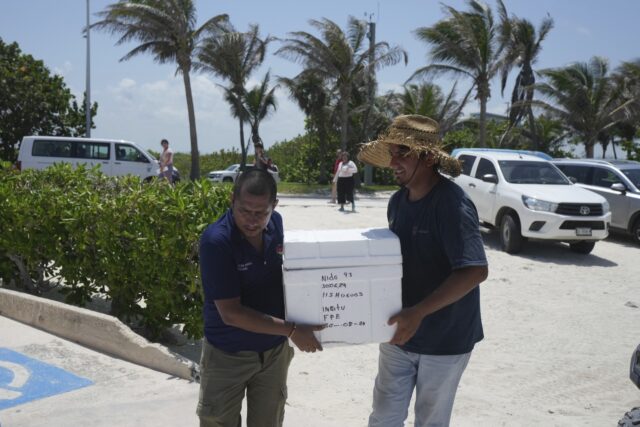Stung by past failures to prepare for hurricanes, the Mexican government is evacuating even sea turtle eggs from beaches ahead of Hurricane Beryl
Mexico evacuates even sea turtle eggs from beaches as Hurricane Beryl approachesBy FERNANDO LLANOAssociated PressThe Associated PressCANCUN, Mexico
CANCUN, Mexico (AP) — Stung by past failures to prepare for hurricanes, the Mexican government on Wednesday began evacuating even sea turtle eggs from beaches ahead of Hurricane Beryl.
While Beryl remains far offshore in the Caribbean near Jamaica, it is expected to hit somewhere south of Cancun by late Thursday or early Friday.
Given that Mexico did so little to warn or evacuate residents of the Pacific coast resort of Acapulco during Hurricane Otis in October, this time around officials are being extra cautious, digging up recently laid sea turtle eggs for fear they could be washed away by the storm surge.
Government employees kept the carey sea turtle eggs covered with sand in dozens of coolers while transferring them to safer spots.
In other areas, they used sand-bag barriers to create safe “corrals” to protect turtles nests against the expected strong waves.
Biologist Graciela Tiburcio, one of Mexico’s foremost sea turtle experts, said it was an extreme measure that might cause some excess failure to hatch among the turtle eggs.
“Look, it’s not the best thing to do, but we are facing an emergency in which if they don’t take them out, they all could be lost,” said Tiburcio, who was not involved in the effort.
Several species of sea turtles come ashore in and around Cancun to lay their eggs in the sand, where hatchlings will emerge a few weeks later and crawl into the sea. Normally, people are told not to disturb the nests, because the sand keeps them at the ideal temperature for hatching.
Moreover, sea turtles are believed to use the natural light on the beaches to orient themselves, and in many cases, return to the same spot themselves after they become adults.
But Beryl’s waves and storm surge could simply sweep them out to sea, where they couldn’t hatch.
“In a normal situation this would not be right, because this will surely cause mortality,” said Tiburcio. “There will be a lower rate of hatched eggs, that is the reality. But it’s also a reality that if the nests are left there, they’ll all be lost.”
The Cancun municipal environment department did not immediately respond to requests for comment on where the turtle eggs were being taken for safekeeping. But in a social media post, the office said it had dug up over 10,000 eggs from around 93 nests.
Carey turtles, like all sea turtles, are protected species in Mexico and removing their eggs — which were once widely eaten — is prohibited.
It’s not just turtles: Further south in the Caribbean coast, in the fishing village of Punta Allen, soldiers, police and marines were strongly pressing the 700 inhabitants to completely evacuate their homes.
Punta Allen is located on a narrow spit of land south of the resort of Tulum.
One resident of Punta Allen who asked to remain anonymous said many residents, about half the population, were resisting the calls to evacuate.
“They’re asking everyone to get out of Punta Allen … but people don’t want to leave,” she said. “They don’t have any money and they don’t want to leave their possessions.”
Moreover, the woman said, the government offers free transportation out, but doesn’t give people rides back once the hurricane has passed.
Many in Mexico have long distrusted the government’s disaster preparedness efforts, because officials often don’t enforce zoning and safety rules, and do little before the storms.
Acapulco is still struggling to recover after being hit by Category 5 Hurricane Otis in October. Otis left at least 52 dead and destroyed or damaged most hotels.
___
Follow AP’s coverage of Latin America and the Caribbean at https://apnews.com/hub/latin-america

COMMENTS
Please let us know if you're having issues with commenting.